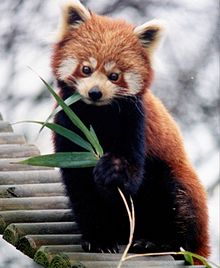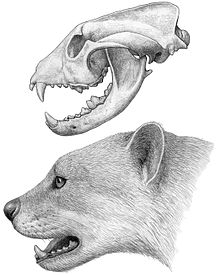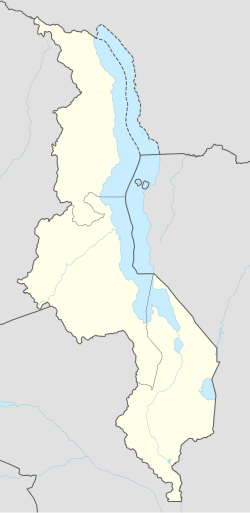아일루리과
Ailuridae| 아일루리과 시간 범위: | |
|---|---|
 | |
| 레서판다 (Ailurus fulgens) | |
 | |
| 시모시온의 두개골 및 생명 복원 | |
| 과학적 분류 | |
| 도메인: | 진핵생물 |
| 킹덤: | 애니멀리아 |
| 문: | 초르다타 |
| 클래스: | 포유류 |
| 순서: | 카르니보라 |
| 슈퍼패밀리: | 무스텔로이드상과 |
| 가족: | 아일루리과 그레이, 1843 |
| 하위 패밀리 | |
 | |
| 현존하는 레서판다 분포 | |
아일루리과(Ailuridae)는 포유류 목에 속하는 과입니다.이 과는 레서판다(살아있는 유일한 대표)와 멸종된 동족으로 이루어져 있습니다.
조르주 큐비에는 1825년에 일루루스를 너구리과에 속한다고 처음 기술했습니다.[1]머리의 형태학적 유사성, 유색고리꼬리, 기타 형태학적, 생태학적 특징 등으로 인해 너구리과로 분류되었습니다.얼마 후 곰과에 배정되었습니다.[2]
분자 계통발생학적 연구에 따르면, 고대의 육식동물로서, 레서판다는 아메리카 너구리와 비교적 가깝고 단형과이거나 프로시온과에 속하는 아과일 수 있습니다.[1][3][4]심층적인 미토콘드리아 DNA 집단 분석 연구는 "화석 기록에 따르면, 레드 팬더는 약 4천만년 전 곰과 공통 조상에서 갈라졌습니다."라고 말했습니다.[1][5]이러한 차이를 이용하여, 판다와 너구리의 서열 차이를 비교함으로써, 관찰된 판다의 돌연변이율은 10개9 정도로 계산되었는데, 이는 포유류의 평균적인 비율과 비교했을 때 명백히 과소 추정된 것입니다.[6]이러한 과소평가는 아마도 레서판다와 너구리 사이의 분열이 극도로 깊기 때문에 여러 번 반복되는 돌연변이 때문일 것입니다.[citation needed]
가장 최근의 분자 체계적인 DNA 연구는 판다를 독립적인 가족인 일루리대(Ailuridae)로 분류했습니다.차례로, 아일루리대(Ailuridae)는 넓은 상과(Raccoon)와 메피티대(Mephitidae)와 메피티대(Mephitidae)(스컹크)와 무스텔대(Mephelidae)[8]로 더 세분하는 그룹을 포함하는 넓은 상과(Mustelidea[7])의 삼분절단의 일부입니다; 그러나 곰(Ursidae)은 아닙니다.
아일루리드는 올리고세 후기에서 미오세 초기 유럽에서 기원한 것으로 보입니다.가장 초기에 알려진 암픽티스는 이빨로 보아 전문적이지 않은 육식동물이었을 가능성이 높습니다.아일루리드는 그 후 아시아와 북아메리카로 퍼져나갔습니다.유럽, 북아메리카, 중국의 플라이오세 중기에서 발견된 퓨마 크기의 시모시온은 육식동물이었을 가능성이 높습니다.현대의 레서판다와 마찬가지로 등반을 돕기 위한 "허위 엄지"를 가지고 있었습니다.멸종된 프리스티나일루루스속과 파라일루루스속 뿐만 아니라 현대의 붉은 팬더속을 포함하는 아일루리아과의 구성원들은 무른 혹을 가진 특수한 치과 형태학을 발전시켜 식물 재료를 가공하기 위한 효과적인 분쇄 표면을 만들었습니다.[9]
분류
다른 육식동물과의 일루리대의 관계는 플린, 2005년의 6개 유전자의 분자 계통발생학적 분석에 기초한 다음과 같은 계통발생학 트리에 나와 있습니다.[10]
| 카르니보라 |
| ||||||||||||||||||||||||||||||||||||||||||
아일루루스과(Ailuridae)는 아일루루스과 외에도 7개의 멸종된 속을 포함하고 있으며, 대부분은 3개 아과에 속합니다.암픽티아과와 시모시오니아과 그리고 아일루리아과.[11][12][13][14][15]
- J.E.과 그레이, 1843
- †아과 (Amphictinae)?윙에, 1896
- †암픽치?포멜, 1853
- †Ampictis borbonica Viret, 1929
- †Ampictis ambigua (Gervais, 1872)
- †Ampictis milloquensis (Helbing, 1936)
- †Ampictis antiqua (de Blainville, 1842)
- †Ampictis schlosseri Heizmann & Morlo, 1994
- †1996년 Morlo에서 양막이 연장되었습니다.
- †Ampictis wintershofensis Roth, 1994
- †Ampictis cuspida Nagel, 2003
- †암픽은 티무쿠아 J.A. 배스킨, 2017[16]
- †암픽치?포멜, 1853
- †아과 (Simocyoninae Dawkins), 1868
- †액티오시온 스톡, 1947
- †Actiocyon parverratis Smith et al., 2016[17]
- †Actiocyon leardi Stock, 1947
- †알로페코시온 캠프 & 밴더후프, 1940
- †알로페코시온 게티 마인, 1958
- †알로페코시온 괴리아헨시스 (Toula, 1884)
- †프로투스 크루사폰트 & 쿠르텐, 1976
- †프로투르수스 심슨 크루사폰트 & 쿠르텐, 1976
- †Simocyon Wagner, 1858
- †Simocyon primigenius (Roth & Wagner, 1854)
- †Simocyon diphorus (Kaup, 1832)
- †Simocyon bataleri Viret, 1929
- †Simocyon hungaricus Kadic & Kretzoi, 1927
- †액티오시온 스톡, 1947
- J.E. 아과 그레이, 1843
- †Magericis Ginsburg et al., 1997
- †Magerictis imperialensis Ginsburg et al., 1997
- 트라이브 프리스티나일루리니 월레스 & 리옹, 2022
- †Pristinailurus Wallace & Wang, 2004
- †Pristinailurus Bristoli Wallace & Wang, 2004
- †Parailurus Schlosser, 1899
- †Parailurus hungaricus Kormos, 1935년, Dawkins, 1888)
- †Parailurusted for di Wallace & Lyon, 2022
- †Parailurus baikalicus Sotnikova, 2008
- †Pristinailurus Wallace & Wang, 2004
- 아일루리니 부족
- 아일루루스 F. 큐비어, 1825
- 아일루루스속 (Ailurus fulgens) - 레서판다
- Ailurus fulgens styani Thomas, 1902 – 동부 붉은 팬더
- Ailurus는 F를 활성화시킵니다. 큐비어, 1825 – 서부 레서판다
- 아일루루스속 (Ailurus fulgens) - 레서판다
- 아일루루스 F. 큐비어, 1825
- †Magericis Ginsburg et al., 1997
- †아과 (Amphictinae)?윙에, 1896
"Ailurinae indet"이라고 불리는 이름 없는 분류군은 2001년 프랑스 이세레 근처의 중미오세 시대 지역인 Four의 상부 어금니를 기준으로 설명되었습니다.[18]
참고문헌
- ^ a b c Mayr, E. (1986). "Uncertainty in Science: is the Giant panda a bear or a raccoon?". Nature. 323 (6091): 769–771. Bibcode:1986Natur.323..769M. doi:10.1038/323769a0. PMID 3774006. S2CID 4317414.
- ^ Roberts, M.S.; Gittleman, J.L. (1984). "Ailurus fulgens". Mammalian Species. American Society of Mammalogists (222): 1–8. doi:10.2307/3503840. JSTOR 3503840.
- ^ Zhang, Y.P.; Ryder, O.A. (1993). "Mitochondrial DNA sequence evolution in the Arctoidea". PNAS. 90 (20): 9557–9561. Bibcode:1993PNAS...90.9557Z. doi:10.1073/pnas.90.20.9557. PMC 47608. PMID 8415740.
- ^ Slattery, J.P.; O'Brien, S.J. (1995). "Molecular Phylogeny of the Red Panda (Ailurus fulgens)". J. Hered. 86 (6): 413–422. doi:10.1093/oxfordjournals.jhered.a111615. PMID 8568209.
- ^ Bing, Su; Fu, Yunxin; Wang, Yingxiang; Jin, Li; Chakraborty, Ranajit (2001). "Genetic Diversity and Population History of the Red Panda (Ailurus fulgens) as Inferred from Mitochondrial DNA Sequence Variations". Molecular Biology and Evolution. 18 (6): 1070–1076. doi:10.1093/oxfordjournals.molbev.a003878. PMID 11371595.
- ^ Li, Wen-Hsiung (2007). Molecular Evolution. Sinauer Associates. ISBN 978-0-87893-480-5.[페이지 필요]
- ^ 플린 외, 2001[full citation needed]
- ^ Flynn, John J.; Nedbal, Michael A.; Dragoo, Jerry W.; Honeycutt, Rodney L. (1 November 2000). "Whence the Red Panda?" (PDF). Molecular Phylogenetics and Evolution. 17 (2): 190–99. doi:10.1006/mpev.2000.0819. ISSN 1055-7903. PMID 11083933. Archived from the original (PDF) on 13 April 2018. Retrieved 11 February 2018.
- ^ Salesa, Manuel J.; Peigné, Stéphane; Antón, Mauricio; Morales, Jorge (2022), "Evolution of the family Ailuridae: origins and Old-World fossil record", Red Panda, Elsevier, pp. 15–29, doi:10.1016/b978-0-12-823753-3.00007-7, ISBN 9780128237533, S2CID 243825496, retrieved 2022-06-29
- ^ Flynn, J.J.; Finarelli, J.A.; Zehr, S.; Hsu, J.; Nedbal, M.A. (2005). "Molecular phylogeny of the Carnivora (Mammalia): Assessing the impact of increased sampling on resolving enigmatic relationships". Systematic Biology. 54 (2): 317–337. doi:10.1080/10635150590923326. PMID 16012099.
- ^ McKenna, M.C.; Bell, S.K. (1997). Classification of Mammals Above the Species Level. Columbia University Press. ISBN 9780231528535.[페이지 필요]
- ^ Peigné, S.; Salesa, M.; Antón, M.; Morales, J. (2005). "Ailurid carnivoran mammal Simocyon from the late Miocene of Spain and the systematics of the genus" (PDF). Acta Palaeontologica Polonica. 50: 219–238.
- ^ Salesa, M.; Antón, M.; Peigné, S.; Morales, J. (2006). "Evidence of a false thumb in a fossil carnivore clarifies the evolution of pandas". Proceedings of the National Academy of Sciences. 103 (2): 379–382. Bibcode:2006PNAS..103..379S. doi:10.1073/pnas.0504899102. PMC 1326154. PMID 16387860.
- ^ Wallace, S.C.; Wang, X. (2004). "Two new carnivores from an unusual late Tertiary forest biota in eastern North America". Nature. 431 (7008): 556–559. Bibcode:2004Natur.431..556W. doi:10.1038/nature02819. PMID 15457257. S2CID 4432191.
- ^ Morlo, Michael; Peigné, Stéphane (2010). "Molecular and morphological evidence for Ailuridae and a review of its genera". In Goswami, Anjali; Friscia, Anthony (eds.). Carnivoran Evolution: New Views on Phylogeny, Form, and Function. pp. 92–140. doi:10.1017/CBO9781139193436.005. ISBN 978-0-521-73586-5.
- ^ Baskin, Jon A. (2017). "Additional carnivorans from the early Hemingfordian Miller Local Fauna, Florida". Journal of Vertebrate Paleontology. 37 (2): e1293069. Bibcode:2017JVPal..37E3069B. doi:10.1080/02724634.2017.1293069. S2CID 90182619.
- ^ Smith, Kent; Czaplewski, Nicholas; Cifelli, Richard (2016). "Middle Miocene carnivorans from the Monarch Mill Formation, Nevada". Acta Palaeontologica Polonica. 61 (1): 231–252. doi:10.4202/app.00111.2014.
- ^ Ginsburg, Leonard; Maridet, Olivier; Mein, Pierre (2001). "Un Ailurinae (Mammalia, Carnivora, Ailuridae) dans le Miocène moyen de Four (Isère, France)" [An Ailurinae (Mammalia, Carnivora, Ailuridae) in the middle Miocene of Four (Isère, France)]. Geodiversitas (in French). 23 (1): 81–85.
추가열람
- Davis D. Dwight (1964). "The Giant Panda: A Morphological Study of Evolutionary Mechanisms". Zoology Memoirs. 3: 1–339.
- Decker D.M., Wozencraft W.C. (1991). "Phylogenetic Analysis of Recent Procyonid Genera". Journal of Mammalogy. 72 (1): 42–55. doi:10.2307/1381979. JSTOR 1381979.
- 플린, J.J. 그리고 G.D.웨슬리 헌트.(2005a).태반 포유류의 부상에서 "카니보라". 현존하는 주요 계급의 기원, 시기 및 관계, D.아치볼드와 K.로즈. 볼티모어.ISBN 0-8018-8022-X
- Flynn John J; et al. (2005b). "Molecular phylogeny of the Carnivora (Mammalia): ASS-ASS the impact of increased sampling to on resolving enigmatic relationships". Systematic Biology. 54 (2): 1–21. doi:10.1080/10635150590923326. PMID 16012099.
- 플린, 존 J. 플린, 마이클 A.네드발, J.W. 드래구, R.L. 허니컷.(1998) "붉은 팬더는 언제?"분자 계통발생학과 진화.제17권 제2호, 2000년 11월, 페이지 190-199. [1]
- 글래츠턴, A.R. (1989)판다 생물학에 대해 이야기 해보세요.헤이그.ISBN 90-5103-026-6
- 글래츠턴, A.R. (컴파일러) (1994)"붉은 판다, 올링고스, 코아티스, 너구리와 그들의 친척들:Procyonids 및 Ailurids에 대한 현황 조사 및 보존 조치 계획"
- IUCN/SSC Mustelid, Viverrid, Procyonid Specialist Group.IUCN/SSC, 글랜드, 스위스.
- Gregory W.K. (1936). "On the Phylogenetic Relationships of the Giant Panda (Ailuropoda) to other Arctoid Carnivores". American Museum Novitates (878): 1–29.
- 후, J.C. (1990)"붉은 팬더에 대한 연구 진행"중국 과학 출판사, 베이징, 중국 [중국어].
- 윌슨, 돈 E. 그리고 디앤 M. 리더.(2005).세계 종의 포유류.존스 홉킨스 대학 출판부.ISBN 0-8018-8221-4.


